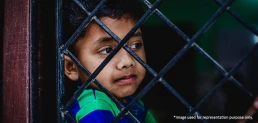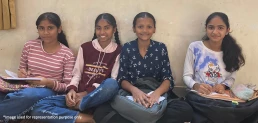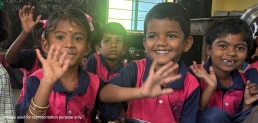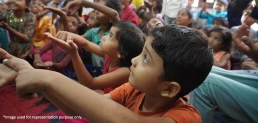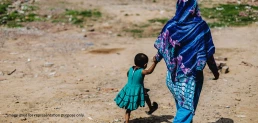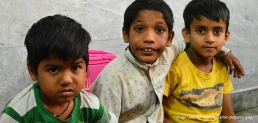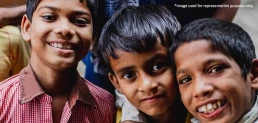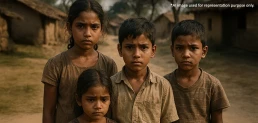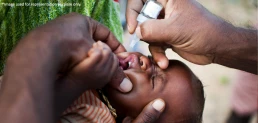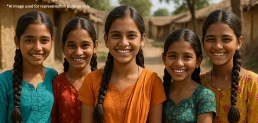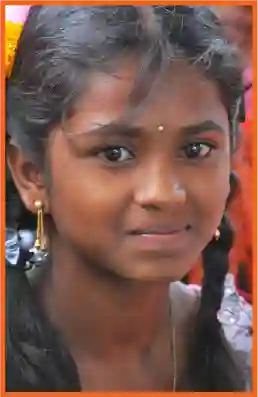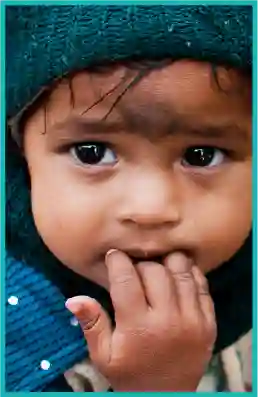- What is Anemia, and Why is it a Major Concern for Rural Children?
- Identifying the Signs of Anemia in Children
- Risk Factors Contributing to Anemia in Rural Areas
- What Causes Anemia in Children?
- How CRY America is Fighting Anemia in Rural Children
- Identifying and Acting: From Signs to Solutions
- Final Thoughts
- FAQ
Anemia in children is a serious health issue that disproportionately affects rural areas in India. It undermines growth, learning, immunity, and long-term development. This guide explores what anemia is, why rural children are at risk, how to identify symptoms, the underlying causes and risk factors of anemia in children, and how CRY America is addressing this issue. It concludes with suggestions for contributing to change.
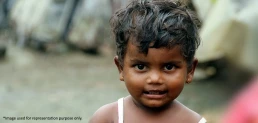

What is Anemia, and Why is it a Major Concern for Rural Children?
Anemia is defined as a lower-than-normal hemoglobin concentration in blood, reducing oxygen delivery to organs and tissues. Hemoglobin levels drop below 11 g/dL in children aged 6–59 months, according to India’s NFHS-5 data, with a prevalence of 67.1% in this group.
Major concerns:
- Impaired brain development, reduced attention span, and learning difficulties
- Increased susceptibility to infections and fatigue
- Poor school performance and decreased physical capacity
Rural context:
- Restricted access to iron-rich foods and healthcare
- Prevalent anemia becomes intergenerational, affecting community well-being
Also Read: What is malnutrition?
Why Rural Children Are More Vulnerable to Anemia
Rural settings amplify vulnerability due to:
- Lower socioeconomic status and food insecurity
- Poor dietary diversity: dependence on grains over iron-rich foods
- Limited access to health services and routine screening
- Environmental risks: high incidence of parasitic infections (e.g., hookworm, malaria)
- Cultural norms limiting nutrition for girls and young children
Identifying the Signs of Anemia in Children
Early identification is key, as signs of anemia in children may be subtle:
Common Symptoms of Anemia in Children
Bulleted list of symptoms, supported by pediatric sources:
- Pale skin, lips, hands, and under the eyelids
- Irritability and fussiness in toddlers
- Low energy, fatigue, fast heartbeat (tachycardia)
- Sore/swollen tongue, mouth ulcers
- Pica (eating non-food items like dirt or ice)
- Headaches, dizziness, shortness of breath, palpitations
The Consequences of Unrecognized Anemia
- Delayed growth, cognitive, and psychomotor development
- Weakened immunity, increased infection risk
- School absenteeism and long-term performance setbacks
- In severe cases: heart strain, heart failure, and life-threatening complications
| Level of Anemia | Hemoglobin Range | Possible Effects |
| Mild | 10.0-19.0 g/dl | Often asymptomatic, slight cognitive effects |
| Moderate | 7.0-9.9 g/dl | Fatigue, pale appearance, reduced activity |
| Severe | <7.0 g/dl | Paleness, tachycardia, growth delays, cardiac strain |
Also Read: Protect the Health and Nutrition of Marginalized Children in India
Risk Factors Contributing to Anemia in Rural Areas
Limited Access to Nutrition and Healthcare
- Low-income households struggle to afford iron-rich foods
- Skewed diets with rice, millet, and starchy staples
- Lack of fresh fruit/vegetable intake
- Inadequate supplementation and weak screening by ASHA workers
- Insufficient Deworming and Iron Folic Acid programs, despite India’s Anemia Mukt Bharat
Environmental and Cultural Factors Affecting Child Health
- High burdens of parasitic infections and malaria
- Cultural feeding norms prioritizing adults over children
- Gender norms affecting diet for girls and boys alike
- Unsafe water/sanitation leading to repeated infections
Also Read: Prioritizing Health and Nutrition for At-Risk Children in India
What Causes Anemia in Children?
Anemia in children arises due to a mix of nutritional deficiencies and health conditions:
Nutritional Deficiencies: Iron, Folate, and Vitamin B12
- Iron deficiency is the most common cause
- Additional deficiencies: folate, vitamin B12, and vitamin A
- Inadequate dietary intake and poor absorption due to GI issues
Infections and Medical Conditions Leading to Anemia
- Chronic infections: malaria, tuberculosis
- Parasitic infestations: hookworm leading to blood loss
- Hemoglobinopathies (like thalassemia) are genetic contributors
- Chronic diseases, blood loss, and impaired iron metabolism
Also Read: Role of Nutrition
How CRY America is Fighting Anemia in Rural Children
CRY America supports holistic, evidence-based interventions aligned with Indian government programs to combat anemia:
- Nutrition & Supplementation
- Promotes Iron Folic Acid (IFA) supplementation under Anemia Mukt Bharat
- Encourages dietary diversification: iron-rich meals and vitamin-C intake
- Community Health Screening
- Works with local nonprofits & ASHAs to organize hemoglobin testing camps
- Referrals to primary health centers for treatment and follow-up
- Conducts Community Awareness Programs
- Conducts community hygiene education like WASH programs
- Organizes nutrition Days & educates mothers & community on proper nutrition
- Behavior Change Communication
- Educates caregivers on anemia risks, nutrition, hygiene, and signs of anemia
- Uses audio-visual aids, local advocates, and school-based programs aligned with POSHAN Abhiyaan
- Monitoring & Data
- Champions’ use of government digital platforms for anemia tracking
- Partners with schools and health centers to monitor progress
Also Read: Causes of Gender Inequality
Identifying and Acting: From Signs to Solutions
Signs of Anemia in Children Checklist
- Pale skin, lips, nails, and eyelids
- Persistent tiredness or low activity
- Irritability or emotional change
- Fast heart rate, breathlessness
- Pica behavior
- Recurrent infections or stunted growth
Next Steps if Symptoms Appear
- Hemoglobin test via CBC and ferritin levels
- Nutritional counseling plus supplements (IFA syrup/tablets)
- Deworming and access to hygiene support
- Follow-up monitoring to track recovery
Positive Outcomes: What Restoration Looks Like
Through coordinated action, government programs plus CRY America’s local support, rural children benefit from:
- Improved hemoglobin levels and reduced anemia prevalence
- Better cognitive function and physical energy
- Fewer infections and school absences
- Enhanced community understanding of child nutrition
How to Support the Mission
Positive change, especially for anemia in children, requires community and donor partnership:
- Donate: Funds support nutrition programs & community awareness programs
- Awareness: Share awareness through social platforms and local networks
A donation empowers local teams to reach more children, improving nutrition, health, and future potential.
Final Thoughts
Anemia in rural children is a pressing yet addressable health issue in India. Stronger nutrition, screening, supplementation, hygiene, and behavior change can protect millions of boys and girls. With government initiatives like Anemia Mukt Bharat and community partners like CRY America, solutions are within reach.
Public support, through donations, awareness, and volunteering, is critical to sustaining and expanding these efforts. Every contribution ensures more rural children grow stronger, learn better, and live healthier lives.
FAQ
What are the treatment options available for children suffering from anemia?
Treatment for anemia in children typically includes iron and folic acid supplements, deworming medications, and dietary improvements with iron-rich foods like leafy greens, pulses, and fortified cereals. In moderate to severe cases, doctors may recommend vitamin B12 or iron injections. It’s also important to treat any underlying infections or chronic illnesses contributing to the condition for complete recovery.
How can anemia be prevented in rural communities?
Prevention involves ensuring a balanced diet rich in iron, folate, and vitamin B12, regular deworming, and access to clean drinking water and sanitation. Public health efforts such as IFA supplementation, nutrition education, and maternal care services play a vital role. Promoting kitchen gardens and community awareness through schools and Anganwadi centers helps build long-term prevention systems.
How can parents recognize signs of anemia in children?
Parents should look for persistent tiredness, pale skin or lips, poor appetite, irritability, and delayed physical or mental development. Other signs may include frequent illnesses, shortness of breath during activity, or unusual cravings, such as eating dirt (pica). If such symptoms are observed, it is crucial to get the child’s hemoglobin levels tested at the nearest health center.
Are there any specific groups of children at higher risk for anemia?
Yes, children aged 6 months to 5 years, adolescent girls, and those from low-income, food-insecure households are at higher risk. Children with parasitic infections, poor dietary intake, or chronic diseases like malaria or thalassemia are also vulnerable. In rural areas, a lack of health services and cultural food practices may further elevate this risk.
Recommended for you











